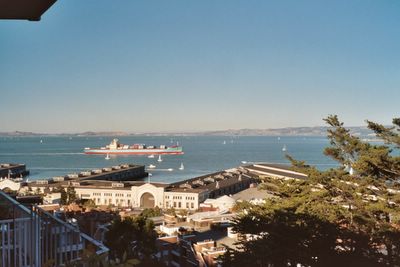Wednesday, February 23, 2005
Recycled paper
Interesting articles in the Merc (by Frank Greve for Knight Ridder) yesterday, in the CoCo Times (by Karl Schoenberger for Knight Ridder) a week ago and elsewhere recently about the amount of scrap paper that is heading over to China from the U.S.
The CoCo article reads, More than one-third of the merchandise passing through Oakland, the Bay Area's shipping gateway, now comes from China or is on its way back. And tellingly, one in three containers leaving Oakland for China or other Asian ports is empty, hard evidence of America's $618 billion trade gap with the world and its $162 billion trade deficit with China last year.
Further on it reads, Incoming containers from China and other parts of Asia bear computer parts, machinery and low-cost clothing. Some outgoing containers are filled with California-grown produce and wine, but most contain the discards of post-industrial society. Recycled paper, metal scrap and other waste material are the port's top exports.
California's biggest export to China these days is said to be scrap paper.
According to the article in the Merc, Americans are recycling paper at a great clip, 300 pounds per capita per year, about half the paper produced in the U.S.
Where does that scrap paper go? Well, there you have discrepancies between the two articles. The CoCo article claims that China is starting to prefer to get empty containers back instead of ones loaded with scrap paper because they can refill and reship them faster.
The Merc article claims that China is hungering for scrap paper to recycle into paperboard for shipping boxes for the goods that fill those container ships heading our way. China is short of trees and, hence, wood pulp. Years ago we were proudly shown a two-hundred-year-old tree, protected by fences, in Chongqing, which had very few trees otherwise.
In addition to improvements in the tactics of waste-paper collection, recycling is gaining from China's suddenly ravenous appetite for U.S. scrap paper. Its hunger for recycled paper is fueled by its own shortage of wood pulp and a mushrooming need for boxes in which to ship its exports.
U.S. papermakers, who need scrap themselves, are struggling to compete against China's mills, which made off with about 6 million tons of American scrap paper in 2004. That's from a total U.S. paper recovery of about 50 million tons. Mills in India, Indonesia, Japan and South Korea also are ardent bidders for American scrap paper.
Exports of U.S. scrap of all kinds have more than doubled in the last five years. Scrap paper is one of the big items. The problem, which is now affecting U.S. paper mills, is that China is willing to pay a higher price than American mills. Because the shipping cost is minimal, only 10% of the actual paper cost, China is now buying up scrap paper from East Coast port cities too. The top four U.S. port cities exporting paper are Los Angeles, New York, San Francisco and Seattle.
Much U.S. scrap paper ends up in the massive new Nine Dragons recycled paper mill in Dongguan, China, north of Hong Kong. It's the world's largest, and is unique in its ability to turn low-quality mixed papers into respectable paperboard for boxes and packaging.
Good news: we're recycling more. Bad news (at least for the American paper pulp industry): Global economics and the joys of capitalism mean the mill in Dongguan can out bid the Americans for American scrap paper.
Keep those ships loaded going to and fro.


The CoCo article reads, More than one-third of the merchandise passing through Oakland, the Bay Area's shipping gateway, now comes from China or is on its way back. And tellingly, one in three containers leaving Oakland for China or other Asian ports is empty, hard evidence of America's $618 billion trade gap with the world and its $162 billion trade deficit with China last year.
Further on it reads, Incoming containers from China and other parts of Asia bear computer parts, machinery and low-cost clothing. Some outgoing containers are filled with California-grown produce and wine, but most contain the discards of post-industrial society. Recycled paper, metal scrap and other waste material are the port's top exports.
California's biggest export to China these days is said to be scrap paper.
According to the article in the Merc, Americans are recycling paper at a great clip, 300 pounds per capita per year, about half the paper produced in the U.S.
Where does that scrap paper go? Well, there you have discrepancies between the two articles. The CoCo article claims that China is starting to prefer to get empty containers back instead of ones loaded with scrap paper because they can refill and reship them faster.
The Merc article claims that China is hungering for scrap paper to recycle into paperboard for shipping boxes for the goods that fill those container ships heading our way. China is short of trees and, hence, wood pulp. Years ago we were proudly shown a two-hundred-year-old tree, protected by fences, in Chongqing, which had very few trees otherwise.
In addition to improvements in the tactics of waste-paper collection, recycling is gaining from China's suddenly ravenous appetite for U.S. scrap paper. Its hunger for recycled paper is fueled by its own shortage of wood pulp and a mushrooming need for boxes in which to ship its exports.
U.S. papermakers, who need scrap themselves, are struggling to compete against China's mills, which made off with about 6 million tons of American scrap paper in 2004. That's from a total U.S. paper recovery of about 50 million tons. Mills in India, Indonesia, Japan and South Korea also are ardent bidders for American scrap paper.
Exports of U.S. scrap of all kinds have more than doubled in the last five years. Scrap paper is one of the big items. The problem, which is now affecting U.S. paper mills, is that China is willing to pay a higher price than American mills. Because the shipping cost is minimal, only 10% of the actual paper cost, China is now buying up scrap paper from East Coast port cities too. The top four U.S. port cities exporting paper are Los Angeles, New York, San Francisco and Seattle.
Much U.S. scrap paper ends up in the massive new Nine Dragons recycled paper mill in Dongguan, China, north of Hong Kong. It's the world's largest, and is unique in its ability to turn low-quality mixed papers into respectable paperboard for boxes and packaging.
Good news: we're recycling more. Bad news (at least for the American paper pulp industry): Global economics and the joys of capitalism mean the mill in Dongguan can out bid the Americans for American scrap paper.
Keep those ships loaded going to and fro.


: views from the Hill
Bertold Brecht:
Everything changes. You can make
A fresh start with your final breath.
But what has happened has happened. And the water
You once poured into the wine cannot be
Drained off again.
Everything changes. You can make
A fresh start with your final breath.
But what has happened has happened. And the water
You once poured into the wine cannot be
Drained off again.


